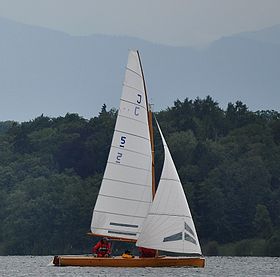J-dinghy
| 22 m² racing dinghy - class symbol | |
|---|---|

|
|
| Technical specifications | |
| Length above : | Max. 6.10 m |
| Width above sea level : | min. 1.70 m |
| Freeboard : | min. 0.4 m |
| Draft : | 0.10 m / 1.10 m below the keel |
| Rigging height: | 8.80 m |
| Weight (ready to sail): | 350 - 550 kg |
| Sail areas | |
| Sail area reduced / sail area close to the wind: | 22 m² / approx. 27 m² |
| Mainsail : | Max. 17.6 m² |
| Headsail ( jib / genoa ): | approx. 11 m² |
| Spinnaker : | Max. 35.5 m² |
| Others | |
| Yardstick number : | 100 to 123 |
| Class: | Construction class |
| Class Association : | International J-dinghy association 22-m² racing dinghies |
The J-Jolle is the oldest German dinghy class and among the four names J dinghy , single dinghy , 22-m-Rennjolle or National dinghy known.
Building regulations from 1910
- Length and width: 7.80 m
- Sail area: 22 m²
- Minimum width of the deck: 1.70 m
- maximum length: 6.10 m
- minimum width of the construction waterline : 1.50 m
- maximum crew: 3 men
- minimum weight 450 kg
- Construction: oak-on-oak clinker
- maximum price: 1,000 RM
- Paid crew was forbidden.
history
The dinghy was designed in 1909 by the German Sailing Association as a national dinghy . The DSVb. responded to the rapid growth of small sailing ships. The boat was intended as a cheap training boat. About 300 national dinghies had been built by 1915 . The character of the training boat soon disappeared, because the sailors developed fast racers to win regattas.
In 1916 the building regulations were adapted: weight and price limits were no longer applicable, the boats could be planked with woods other than oak. You were now to build karwel. The J (pronounced I) was introduced as a sailing symbol in 1919 . The dinghies weigh around 400 kg with a length of about 6 m and are rigged with a real sail area of over 30 m². Spinnaker and backstays are part of the equipment. The 22 m² racing dinghy is a team boat that challenges all three sailors equally. The dinghies are very fast and start planing easily. Until 1945 the inland dinghy was considered the most demanding Central European dinghy class.
The 22 m² racing dinghy was built in:
- Germany
- Austria
- Switzerland
- Hungary
- Italy
- Yugoslavia
Around 600 boats were built. The J-dinghy class was the first dinghy class in which a European championship was held from 1933.
In 1950 the J-dinghy became the DSV age group. J-dinghies regatted in Austria and southern Germany until the 1960s.
Around 100 J-dinghies still exist today, including many from the 1920s, and there are two new buildings.
Class association
The J-dinghy association has existed since 1981 with a focus on Constance on Lake Constance. In 1994 the association was incorporated into the Internationale-J-Jollenvereinigung 22-m²-Rennjollen e. V. passed over. The aim of the association is the preservation and restoration of the old dinghies and regatta sailing.
Regattas
- 1914 to 1942 Seglerhauspreis, held by the VSaW on Wannsee and Havel.
- from 1924 national competitions Hungary-Austria on Lake Balaton, 1925 Wörthersee, 1930 Hungary-Germany-Italy on Lake Balaton, 1932 Hungary-Germany-Italy-Austria on Lake Wannsee
- 1932 to 1942 lake competitions: International regatta series over 2 to 5 lakes, teams were formed from three dinghies from each lake / country. The regattas took place on Wannsee / Havel (D), Ammersee (D), Wörthersee (AU), Balaton (H), St. Moritzsee (CH)
- 1933 to 1939 European championship on Lake Balaton, 1934 on the Wörthersee, 1935 in Trieste inder Itl. nat. 6m dinghy, 1937 on Lake Zurich, 1938 on Wannsee, 1939 on Lake Balaton failed due to the war.
From 1982 to 2001 the international J-dinghy meeting - the class championship - was held in Konstanz on Lake Constance, since 2002 the EURO has been annually for the EUROPE Cup at different locations (e.g. 2002 Hamburg, 2006 Attersee, 2010 Balaton ), sometimes with 20 dinghies.
